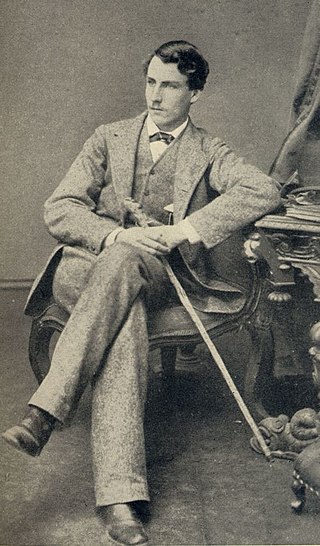Related Research Articles

William Butler Yeats was an Irish poet, dramatist and writer, and one of the foremost figures of 20th-century literature. He was a driving force behind the Irish Literary Revival, and along with Lady Gregory founded the Abbey Theatre, serving as its chief during its early years. He was awarded the 1923 Nobel Prize in Literature, and later served two terms as a Senator of the Irish Free State.
Conradh na Gaeilge is a social and cultural organisation which promotes the Irish language in Ireland and worldwide. The organisation was founded in 1893 with Douglas Hyde as its first president, when it emerged as the successor of several 19th century groups such as the Gaelic Union. The organisation was a spearhead of the Gaelic revival and of Gaeilgeoir activism.

John MacBride was an Irish republican and military leader. He was executed by the British government for his participation in the 1916 Easter Rising in Dublin.
This article contains information about the literary events and publications of 1892.

The Gaelic revival was the late-nineteenth-century national revival of interest in the Irish language and Irish Gaelic culture. Irish had diminished as a spoken tongue, remaining the main daily language only in isolated rural areas, with English having become the dominant language in the majority of Ireland.

Thomas Stanislaus MacDonagh was an Irish political activist, poet, playwright, educationalist and revolutionary leader. He was one of the seven leaders of the Easter Rising of 1916, a signatory of the Proclamation of the Irish Republic and Commandant of the 2nd Battalion, Dublin Brigade of the Irish Volunteers, which fought in Jacob's biscuit factory. He was executed for his part in the Rising at the age of thirty-eight.
The Irish Literary Revival was a flowering of Irish literary talent in the late 19th and early 20th century. It includes works of poetry, music, art, and literature.
The Cuala Press was an Irish private press set up in 1908 by Elizabeth Yeats with support from her brother William Butler Yeats that played an important role in the Celtic Revival of the early 20th century. Originally Dun Emer Press, from 1908 until the late 1940s it functioned as Cuala Press, publicising the works of such writers as Yeats, Lady Gregory, Colum, Synge, and Gogarty.

Thomas William Hazen Rolleston was an Irish writer, literary figure and translator, known as a poet but publishing over a wide range of literary and political topics. He lived at various times in Killiney in County Dublin, the German Empire, London and County Wicklow; settling finally in 1908 in Hampstead, London, where he died. His Killiney home, called Secrora, subsequently became the home of tennis player Joshua Pim.

Alice Letitia Milligan [pseud. Iris Olkyrn] was an Irish writer and activist in Ireland's Celtic Revival; an advocate for the political and cultural participation of women; and a Protestant-unionist convert to the cause of Irish independence. She was at the height of her renown at the turn of the 20th century when in Belfast, with Anna Johnston, she produced the political and literary monthly The Shan Van Vocht (1896–1899), and when in Dublin the Irish Literary Theatre's performed "The Last Feast of the Fianna” (1900), Milligan's interpretation of Celtic legend as national drama.
Events from the year 1893 in Ireland.
Events from the year 1892 in Ireland.

The Faber Book of Irish Verse was a poetry anthology edited by John Montague and first published in 1974 by Faber and Faber. Recognised as an important collection, it has been described as 'the only general anthology of Irish verse in the past 30 years that has a claim to be a work of art in itself ... still the freshest introduction to the full range of Irish poetry'. According to Montague, "I'm dealing with a thousand years of Irish verse in under four hundred pages. I needed a thousand pages.'
The Oxford Book of Irish Verse; XVIIth century - XXth century was a poetry anthology edited by Donagh MacDonagh and Lennox Robinson. It was published "at the Clarendon Press, Oxford" in 1958.

Liam Redmond was an Irish character actor known for his stage, film and television roles.
The New Ireland Review was an Irish literary magazine founded in Dublin, Ireland in 1894. It was founded by Thomas A. Finlay, who was the editor until 1911, when it was replaced by the journal Studies: An Irish Quarterly Review.

Máire Nic Shiubhlaigh was an Irish actress and republican activist. She started acting in her teens and appeared in the first Irish-language play performed in Ireland. She was a founder-member of the Abbey Theatre and was leading lady on its opening night in 1904, when she played the title role in W.B. Yeats's Cathleen Ni Houlihan. She later joined the Theatre of Ireland, which she helped to found.
The National Literary Society was founded in Dublin in 1892 by William Butler Yeats.
Ellen O'Leary (1831–1889) was an Irish poet who sympathised with the Fenian movement. She was the sister of Irish separatist and leading Fenian John O'Leary.
The Society for the Preservation of the Irish Language was a cultural organisation in late 19th-century Ireland, which was part of the Gaelic revival of the period.
References
- ↑ W. P. Ryan: The Irish Literary Revival (1894)
- ↑ Boyd, E. A. Ireland's Literary Renaissance. 1968.
- ↑ 'The Irish Brigade' by Dr. A. Conan Doyle, Irish Literary Society General Report 1897-1898, National Library of Ireland, Ephemera Department.
- ↑ "The Bookman". The Bookman. Great Britain: Hodder & Stoughton. 17: 145. 1900. Retrieved September 11, 2014.